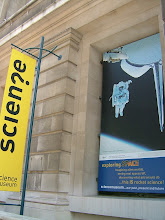CONDENSED-MATTER PHYSICS:Single-Electron Spin Measurement Heralds Deeper Look at Atoms
Erik Stokstad
After 8 years of effort, physicists in California have pulled off a technical tour de force: detecting the spin of a single electron inside a glassy chip of silica. The feat marks a significant step toward seeing individual atoms inside a material--a prerequisite for building a microscope that could map the three-dimensional structure of molecules--and may prove critical for so-called spintronic devices, including some kinds of quantum computers. The new success at imaging a single spin "is a physics breakthrough," says John Sidles of the University of Washington, Seattle.
Researchers can already visualize individual atoms with scanning tunneling and atomic force microscopes, but only on the surface of a sample. They can peer inside materials with magnetic resonance imaging--aligning the spin (a quantum-mechanical property that's the essence of magnetism) of protons in a sample's hydrogen atoms, zapping them with radio waves, and using an induction coil to track the changing magnetic fields as the energized protons return to their equilibrium spin states. The resulting images are useful for doctors, but they are a far cry from atomic resolution: At least a quadrillion protons must respond for a pixel to light up.
Spin detector. Wiggling cantilever, tracked by laser, can spot coil-driven changes in an electron's magnetic orientation.
CREDIT: D. RUGAR ET AL., NATURE 430, 329 (2004)Researchers could sharpen the picture by detecting a proton's spin directly, via magnetic forces, rather than through voltages induced in a coil. That's a tough challenge. These forces, measured in attonewtons, are extremely weak. To make the job easier, a group led by physicist Daniel Rugar of the IBM Almaden Research Center in San Jose, California, set out in 1996 to detect the spin of a single electron, which has a magnetic moment 600 times stronger than a proton's.
The team made a flexible cantilever, just 85 micrometers long and 100 nanometers thin, and added a tiny but powerful magnet at the tip. Applying a high-frequency magnetic field, they manipulated the spin of the electron so that it would resonate with the magnetic field around the cantilever tip. Then they set the cantilever wiggling. If the tip was hovering above an electron with a detectable spin, the resonance repeatedly flipped the spin of the electron, giving the cantilever a slight boost each time. The regular nudging revealed the spin amid the noise created by much stronger electrostatic and van der Waals forces, the researchers report this week in Nature.
It's a slow process right now: Scanning a 170-nanometer stretch of the sample took several weeks. The cantilever's resolution--about 25 nanometers--isn't atomic-scale yet, but the technique can spot an electron as deep as 100 nanometers, or about 400 atomic layers below the surface.
"It's quite an impressive achievement," says physicist Chris Hammel of Ohio State University, Columbus. Unlike other methods of detecting single spins, he says, the new technique has the advantage of working on many kinds of materials. Rugar's team is improving the resolution by cooling the system and outfitting the cantilever with a stronger magnet. That should increase resolution and speed enough to enable 2D and 3D scans, Rugar says.
From: http://www.sciencemag.org/cgi/content/full/305/5682/322a
訂閱:
張貼留言 (Atom)









沒有留言:
張貼留言